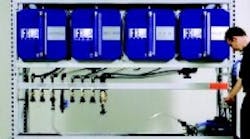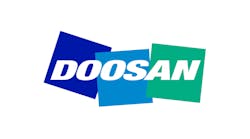This IFH Storage and Dispensing System has eight 65-gallon containers with a spill-containment pan and an operator-controlled pump timer.
MOST SHOPS FIND THE STORAGE and handling of fluids used in their operations an expensive headache. Spills incur costly clean-up procedures and result in expensive lost product. Storing and handling 55-gallon drums takes a lot of valuable shop floor space, results in high labor and maintenance costs and requires much ancillary equipment, including drum pumps, containment cradles, drum racking and drum-handling forklifts. Sloppy fluid handling is not only unsightly, it is also a personnel and fire hazard that results in unnecessarily high insurance costs.
The IFH Group Inc. (www.ifhgroup.com) in Rock Falls, Ill. has a better idea. The company has developed centralized, streamlined fluid storage and dispensing systems, and mobile fluid carts that eliminate all the fluid-handling problems facing manufacturing operations. The centralized units — called IFH Fluid Storage and Dispensing Systems — consist of a number of labeled 65-gallon containers permanently mounted on a rack, each with a labeled faucet and with a drip pan beneath the faucets.
"Our customers' needs vary, and so do the systems we provide," explains Steve Dunkel, director of operations at IFH Group. "For instance, military customers want very standard units with no optional features, whereas manufacturing companies order systems with safety equipment all over their systems, usually because their insurance companies demand it. Most of our industrial customers order these with an optional containment pan that surrounds the entire unit. We build all containment pans to exceed the requirements of EPA regulation 40 CFR 256.175 which dictates the requirements of spill-containment systems for above ground fluid storage."
This regulation stipulates that the containment system must have sufficient capacity to contain 10 percent of the volume of all containers, or the volume of the largest container, whichever is greater. For example, an IFH system with four 65-gallon containers — two wide and two high — contains a total of 260 gallons with a containment capacity of 90 gallons, exceeding the EPA regulation by 25 gallons. A larger, 16-container unit — four high and four wide — contains 1,040 gallons and has a 180-gallon capacity exceeding the regulation by 76 gallons.
The 65-gallon container capacity means that all of the product can be pumped out of a 55-gallon drum and into the system before the overhead container is empty. This reduces the downtime of employees changing drum pumps. Also, the empty drums can be immediately returned to avoid drum deposit charges.
The sight gauges and "gallonage" strips on each system container allow for immediate monitoring of how much fluid is in each container, making inventory control much easier. With the IFH system, shops do not have to keep an extra drum on hand because they are never sure of just how much fluid they have left in the drum.
Each 65-gallon container comes standard with a screened elbow vent to allow for ease of product flow and to prevent major contamination. The vents are also easily upgradeable and can be ordered with desiccant breathers to further eliminate in-tank contamination from moisture and particulate. Quick-coupling filter assemblies are also available to filter product as it is transferred from a 55-gallon drum into one of the system containers.
A positive displacement, self-priming pumping system mounted on the system saves time when filling containers and clears all lines of product, except for a light film, making cleanup after transferring a drum of fluid into the system quick and easy. To fill system containers, a 55-gallon drum is placed next to the unit and a suction hose connected to the pump is inserted in the drum. The pump and suction hose vacuums all of the fluid out of the drum. Typically, drum pumps leave gallons of fluid in the bottom of the drum. The discharge side of the pump is connected to the same faucet that the fluid flows out of. The pump has a timer so an employee doesn't have to attend to the emptying of the drum. By knowing how long it takes to empty a drum, the employee can set the timer to shut off the pump motor when the drum is empty while he or she attends to some other task.
All dispensing faucets and containers come standard with placards that are marked with product names to reduce the chance of the wrong product being used. Self-closing faucets assure no mess or waste when dispensing fluids from the system. The heavy-gauge system racking is also expandable, allowing the system to grow with the company over time.
Shops find the centralized systems save valuable floor space. For example, nine 55-gallon drums, a total of 495 gallons, takes up about 120 square feet, whereas a nine container Fluid Storage and Dispensing System, 585 gallons, takes up 19 square feet, for a saving of 101 square feet. Also, fluid handling costs can be reduced by up to 80 percent because the systems store fluids close to work areas. Many large manufacturers use small systems serving machining cells scattered throughout a plant, thus saving transport time and effort.
Shops looking for even more fluidhandling versatility can combine the efficiency of a centralized storage and dispensing system with the portability of a fluid-handling cart. Small amounts of fluid can be dispensed from system faucets directly into containers, but carts are best for bulk transfer of fluids to the point of need. Carts are useful for shops that use one or a few fluids in several locations around their facility. Shops without a centralized system can fill cart containers directly from 55-gallon drums.
"Ninety percent of the systems and carts we ship are in some way customized to meet specific needs," says Dunkel. "We have 21 different basic configurations of centralized systems and a full line of carts to meet differing shop needs. Our engineering and product development team works with customers to design just the right system or cart for their needs. No shop is too small for our systems or carts. We can build single-container 15-gallon units or 400-gallon multicontainer units. We fabricate our own storage containers and, if a standard 65-gallon container is not the best for a shop, we can supply larger or smaller tanks." Custom options include air or hand powered transfer pumps (electric is standard), pump and reel kits, tow hitches and lifting eyes for carts, meters, explosionproof options, higher grade casters, spill-containment systems, fluid stations to fill carts directly from a system, quick-coupling filtration for filtering fluid as it is transferred into a system or cart, and desiccant filtration that can be installed directly onto system containers for dirty environments.


